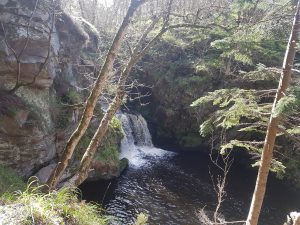The Nature of Speyside
All photos by George Koutsakis.
The annual Spirit of Speyside Whisky Festival has come to a close after, once again, bringing whisky enthusiasts together from all over the world. With Speyside as the stage, the festival sees attendees traveling up and down the region, attending some of the many events held there. This year’s festival ran from May 3rd to May 7th. Both the beauty and downside of the festival is that, with some so many different concepts, dinners, quizzes, and events going on, often simultaneously, guests can’t possibly see it all. They can, however, mix and match and experience the happenings they feel are best for them.
This time around, I experienced the festival from an environmentally friendly angle, as I toured with the Chivas Brothers across their best known sites, and discovered what lies outside, underneath, and around the distilleries. From plants to granite, this year’s Spirit of Speyside festival was eventful, to say the least.
Dalmunach & The Environment
Dalmunach is one the newest distilleries to be added to the Chivas Brothers portfolio. It opened in 2015, and won the Sustainability award that year at the Drinks Business Green Awards.
The distillery produces 10 million litres a year, which become components in the company’s blended whiskies. The site features no aging facilities (those are all kept at a vast facility near Strathisla), and enforces sustainability across the entire distillery. Both the wash and pot stills are energy efficient and feature a heat recovery system which has reduced the distillery’s energy usage by 40%.
The addition of a gas pipeline allows the site to distance itself from heavy fuel and convert some of the energy used into natural gases. The site has managed to achieve a saving of “1,766 tonnes of CO2” according to Graeme Gardiner, the Chivas Brothers associate brand communications manager.
In order to protect the salmon, otter, and Pearl mussel that live in and around the nearby River Spey (where the distillery draws its water) a cutting-edge cooling system was installed, which doesn’t affect the river’s natural state in any way when water is returned to the source. According to Gardiner, “this innovation was used as a case study in the Scotch Whisky Association’s latest environmental strategy report in 2015.”
Going a step further, the site features a sustainable urban drainage system which collects rainfall from roadways within the site, helping to prevent floods and reduce pollution.
Aberlour Trees
A walk around the NY International Spirits Competition medal-winningAberlour distillery, led by the site’s botanist, Kathy Ader, was aimed at introducing the importance of the surrounding land. The abundant sweet Cecily surrounding the site fills the air with a pleasant aroma, which grows stronger in the months of May and June and is said to subtly impact the whisky as it matures. The alder trees surrounding the site, which are also used to make Fender guitars, are instrumental to the area as the species absorbs nitrogen from the air and makes the soil more fertile.
Ader explains why the barks of trees surrounding distilleries are usually black. While the trees are perfectly healthy, a certain type of fungus called Baudoinia compniacensis sticks to them, and alters their colour. The fungus is also known as angel’s share fungus as it is stimulated from the maturing whisky evaporating from the cask. The fungus can capture ethanol in the air and use it as a carbon source, which explains its rapid growth near distilleries.
As we ascend the hills, the land grows rougher and drier, and while not related to whisky production, we get a few fun facts, like the following.
“This is a cultivated form of angelica that is grown as an herb. Its name may have arisen as it was thought to be under the protection of Archangel Michael, while others gave it this holy name due to its seeming ability to cure anything,” Ader tells the group. “For both reasons, it was considered to be a great defence against evil spirits, witches, spells and the plague!”
There you have it, it even kept that plague at bay.
Glenlivet Rocks
My final day at the festival took place at the Glenlivet distillery. In keeping with the environmental tone of the trip, a tasting was focused on the land underneath some of the most well-known Chivas Brothers distilleries - Glenlivet, Aberlour, and Longmorn.
Ronald Daalmans, the Chivas environmental and sustainability manager, led the tasting. We were handed the different types of rock found under each distillery; some were harder, comprising of granite, while others were softer with addition of dirt. Ultimately, the rocks beneath each distillery affect the softness of the water, and its pH level. The harder the rocks, the harder the water. Samples of water from each site were provided, and as Chivas adds nothing to the spring water used in whisky production, the seminar stressed the importance of geology.
While the effects of pH on flavour are debatable, the tasting aimed to educate people on why some distilleries stand where they do, and how the surroundings can effect the history and character of the whisky. Water quality is essential in whisky production, after all.
Finishing off on a wonderful note, the day closed with the first tasting of the new Glenlivet Captain’s Reserve, a Cognac-finished single malt to be released globally this summer.
As usual, the festival brought new and exciting events to life, and offered truly unique experiences. Next year’s Spirit of Speyside will take place from May 2nd to May 6th. Save the date!




